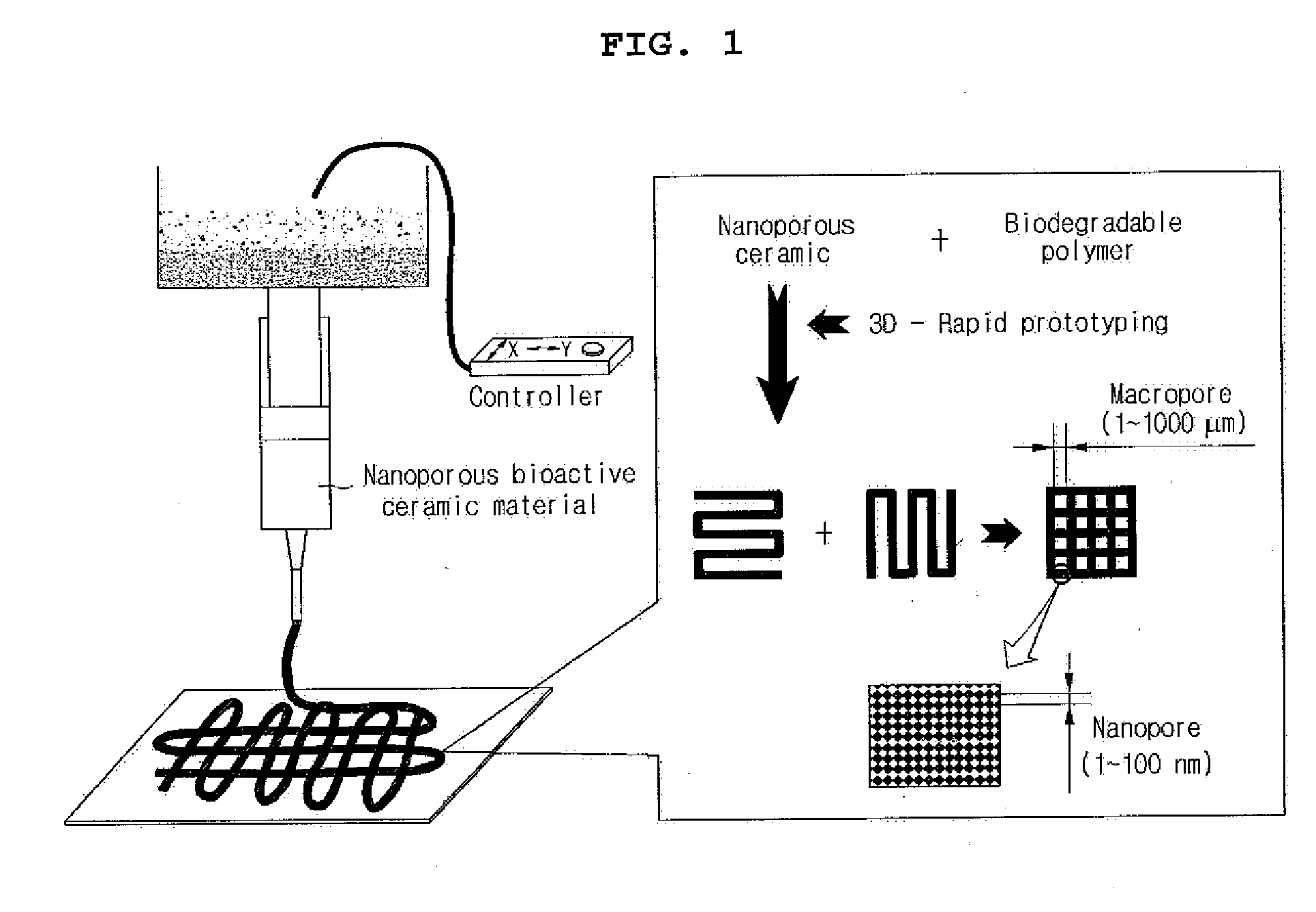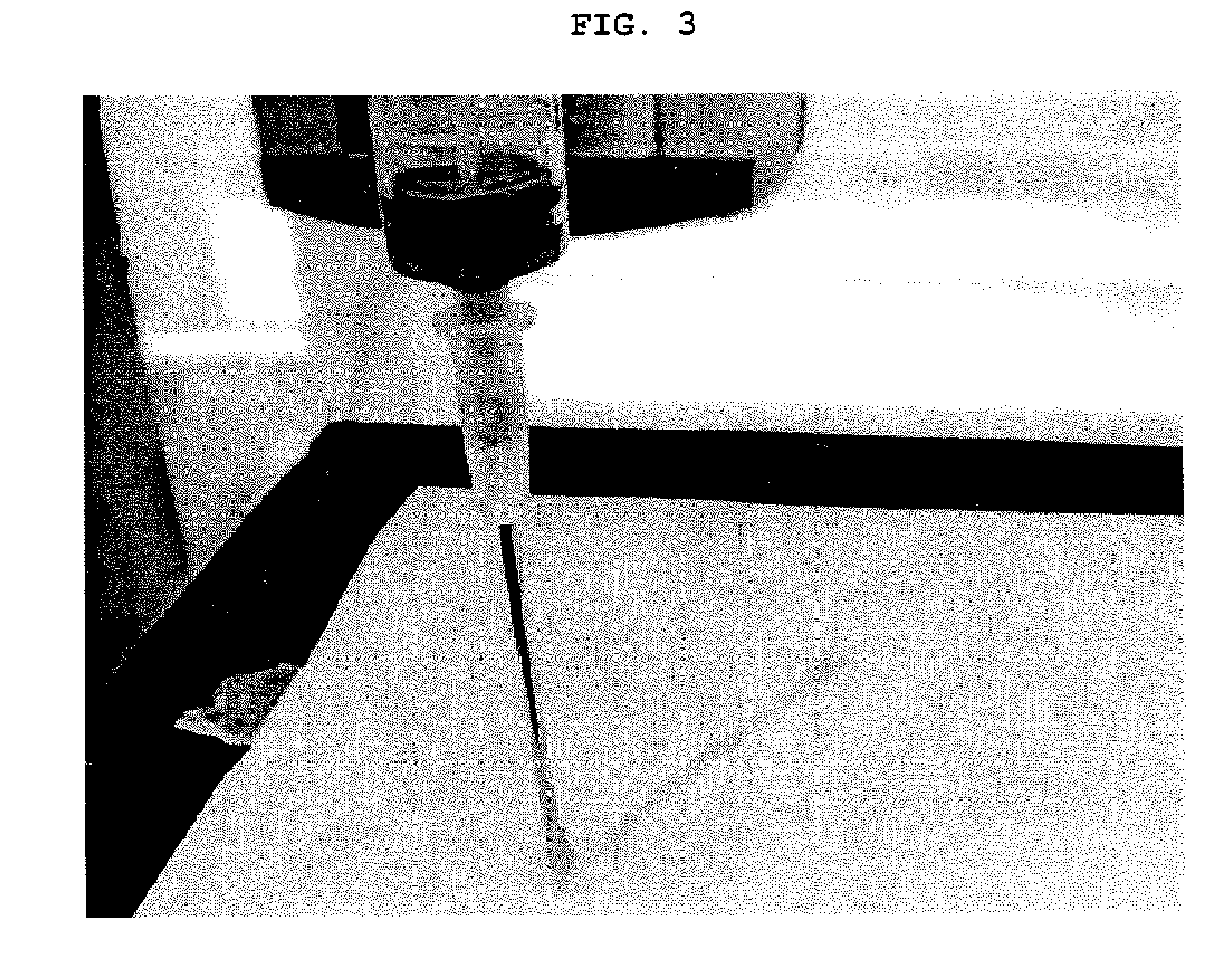Porous material having hierarchical pore structure and preparation method thereof
a porous material and hierarchical pore technology, applied in the field of porous material having hierarchical pore structure and preparation method thereof, can solve the problems of poor functionality of the ceramic frame and poor histological osteoinduction
- Summary
- Abstract
- Description
- Claims
- Application Information
AI Technical Summary
Problems solved by technology
Method used
Image
Examples
example 1
Preparation of Porous Organic-Inorganic Composite Material having Double Pore Structure
[0071]Pluronic F127 ((polyethylene oxide)100(polypropylene oxide)65(polyethylene oxide)100) for inducing the formation of a three-dimensional cubic nanopore structure, and pluronic P123 ((polyethylene oxide)20(polypropylene oxide)70(polyethylene oxide)20) for inducing the formation of a hexagonal nanopore structure were used as a block copolymer template. First, F127 (2.88 g) was added to ethanol (18.1 ml) and then stirred at 40° C. for 0.5˜1 hours until completely dissolved (solution A). Separately, as a bioceramic material or biomaterial, tetraethylorthosilicate (TEOS, 6 ml) and calcium nitrate tetrahydrate (1.36 g) were slowly mixed until uniform, and then triethylphosphate (0.26 ml) was added thereto. Thereafter, this solution was added with a previously prepared mixture of 1 M hydrochloric acid solution (0.95 ml), ethanol (7.62 ml), and distilled water (2.86 ml) and then stirred at 40° C. for...
example 2
Preparation of Porous Bioglass having Triple Pore Structure
[0077]Pluronic F127 ((polyethylene oxide)100(polypropylene oxide)65(polyethylene oxide)100) for inducing the formation of a three-dimensional cubic nanopore structure, and pluronic P123 ((polyethylene oxide)20(polypropylene oxide)70(polyethylene oxide)20) for inducing the formation of a hexagonal nanopore structure were used as a block copolymer template. First, F127 (2.88 g) was added to ethanol (18.1 ml) and then stirred at 40° C. for 0.5˜1 hours until completely dissolved (solution A). Separately, as bioglass material, TEOS (6 ml) and calcium nitrate tetrahydrate (1.36 g) were slowly mixed until uniform, and then triethylphosphate (0.26 ml) was added thereto. Then, this solution was added with a previously prepared mixture of 1 M hydrochloric acid solution (0.95 ml), ethanol (7.62 ml), and distilled water (2.86 ml), and then stirred at 40° C. for 0.5˜1 hours until the inorganic starting material was uniformly dissolved (s...
example 3
Preparation of Porous Glass having Triple Pore Structure
[0082]Pluronic F127 ((polyethylene oxide)100(polypropylene oxide)65(polyethylene oxide)100) for inducing the formation of a three-dimensional cubic nanopore structure, and pluronic P123 ((polyethylene oxide)20(polypropylene oxide)70(polyethylene oxide)20) for inducing the formation of a hexagonal nanopore structure were used as a block copolymer template. First, F127 (2.88 g) was added to ethanol (18.1 ml) and then stirred at 40° C. for 0.5˜1 hours until completely dissolved (solution A). Separately, as a glass material, TEOS (6 ml) was added to a previously prepared mixture of 1 M hydrochloric acid solution (0.95 ml), ethanol (7.62 ml), and distilled water (2.86 ml), and then stirred at 40° C. for 0.5˜1 hours until TEOS was uniformly dissolved (solution B). The solution B was slowly added to the solution A with vigorous stirring at a speed of 700˜1500 rpm at 40° C. for 2˜4 hours.
[0083]The obtained precursor solution (10 ml) wa...
PUM
| Property | Measurement | Unit |
|---|---|---|
| Temperature | aaaaa | aaaaa |
| Temperature | aaaaa | aaaaa |
| Temperature | aaaaa | aaaaa |
Abstract
Description
Claims
Application Information
 Login to View More
Login to View More - R&D
- Intellectual Property
- Life Sciences
- Materials
- Tech Scout
- Unparalleled Data Quality
- Higher Quality Content
- 60% Fewer Hallucinations
Browse by: Latest US Patents, China's latest patents, Technical Efficacy Thesaurus, Application Domain, Technology Topic, Popular Technical Reports.
© 2025 PatSnap. All rights reserved.Legal|Privacy policy|Modern Slavery Act Transparency Statement|Sitemap|About US| Contact US: help@patsnap.com



